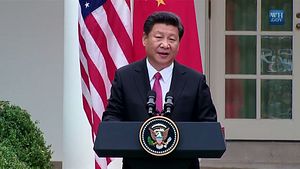It’s been a huge week for U.S.-China relations, with Chinese President Xi Jinping making his first state visit to the country. Despite being only four days long (not counting the time, beginning this week, that Xi will devote to UN activities in New York), Xi’s visit spurred an incredible amount of analysis. Here’s a sampling to get you started on your weekend:
ChinaFile has a collection of experts’ thoughts on Xi’s big speech in Seattle. The general consensus: Xi’s speech was well-crafted and well-delivered, but there’s a lot of skepticism that his actions will live up to his words.
International Business Times has an interesting piece saying that China might actually be ready to alter its approach on economic issues that are of great concern to the United States. The author, Salvador Rodriguez, goes against the trend of op-eds arguing that U.S. tech giants are legitimizing China’s actions by meeting with Xi in Seattle. Over at The Telegraph, for example, Willard Foxton argues that Xi’s meeting with these U.S. business czars will put pressure on Washington to make nice with Beijing.
Meanwhile, the Wall Street Journal put together a handy infographic of that famous picture of U.S. and Chinese executives and Xi Jinping. Now everyone in the picture is identified, along with their motives for attending.
Over at the Center for Strategic and International Studies, James A. Lewis has a piece on how to evaluate U.S.-China progress on cyber issues. Read through it and see how you think Obama and Xi fared. One hint: Lewis says “The Summit would be successful if it was able to define and initiate a political level negotiation (e.g. at the sub-cabinet level), like the arms control negation with the Soviets in the 1970s and 1980s.”
In the category of stories not directly related to Xi’s U.S. trip, but inspired by it, you can’t miss this New York Times piece from Chris Buckley and Didi Kirsten Tatlow. They detail Xi’s experience in the crucible of the Cultural Revolution, where the young man was bullied and taunted over his father’s political status. The piece describes “how a shy, bookish youth, raised in the bosom of party privilege, was tested and changed by the chaos that unfolded after Mao’s decision to turn the masses against the party establishment.” It’s a fascinating tale made all the more interesting by the fact that “bookish youth” is now China’s president.
Jeremy Page at the Wall Street Journal devoted his attention to Xi’s moves since assuming China’s top office – and how he has centralized power in his own hands.
Back at the New York Times, Edward Wong looks at the inner circle who help Xi wield that power through their advice and influence. Worryingly, those top advisers are frosty toward Western officials hoping to strike up relationships.
Looking at U.S.-China relations more broadly, Carnegie Endowment published its report on the results of a survey on how Chinese and Americans perceive each other. The report not only offers statistics on commonly-held beliefs (nearly 90 percent of Chinese think of Americans as aggressive, for example) it offers policy recommendations for how to handle the relationship based on the survey findings.
Of course, I’ve been busy following the visit as well. In addition to my pieces here at The Diplomat, check out my Slate analysis of Xi’s Seattle speech, plus my preview of the visit for CNN.
Finally, the bevy of official statements from the White House on the visit, for those who want to get their summit news straight from the source: fact sheets on economic relations, climate change, and the visit as a whole; a joint presidential statement on climate change; and the transcript of Xi and Obama’s remarks at their press conference.

































